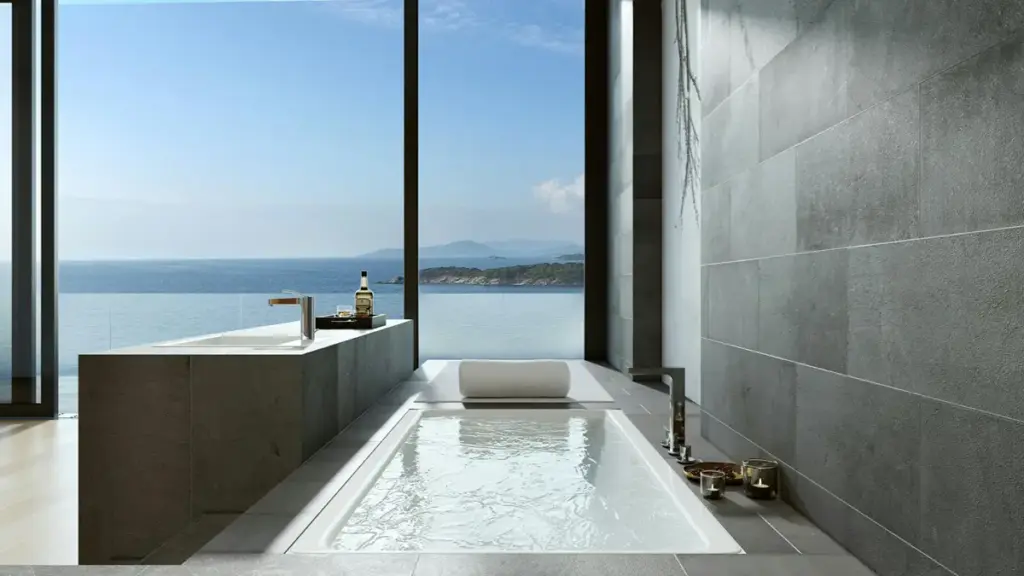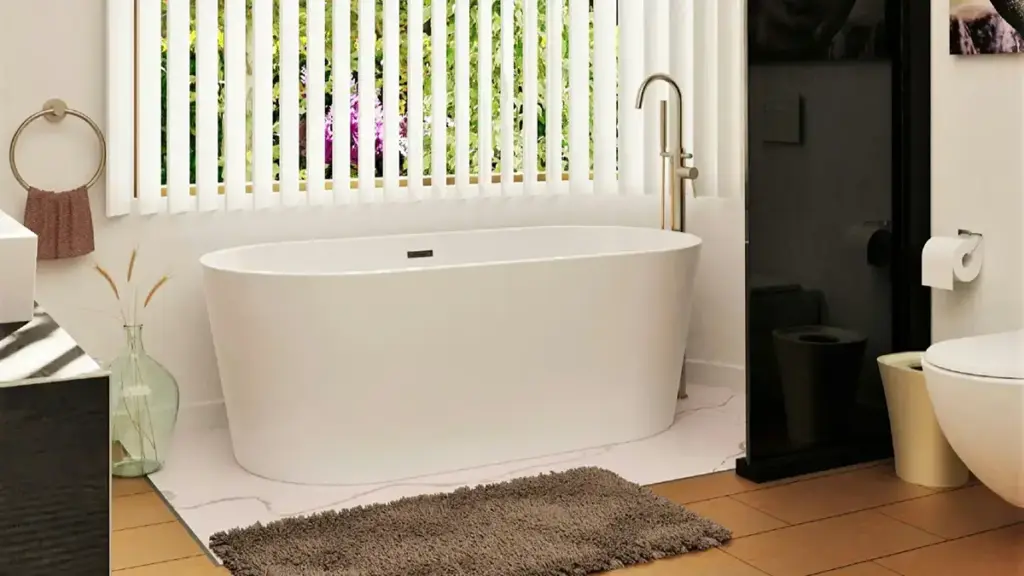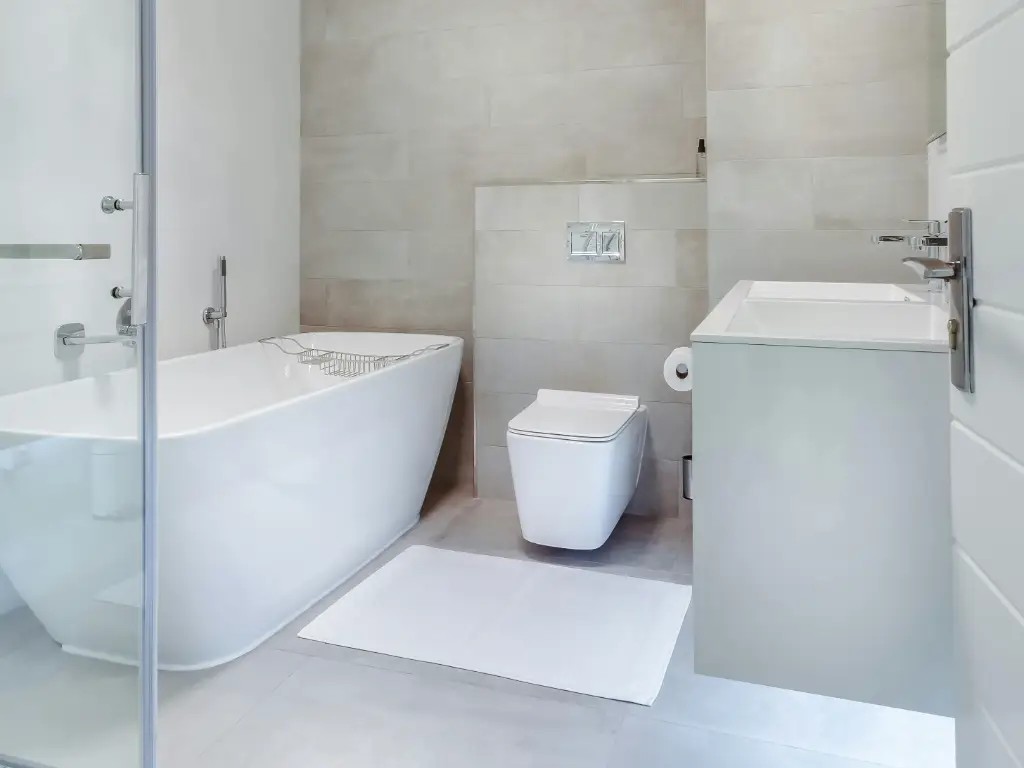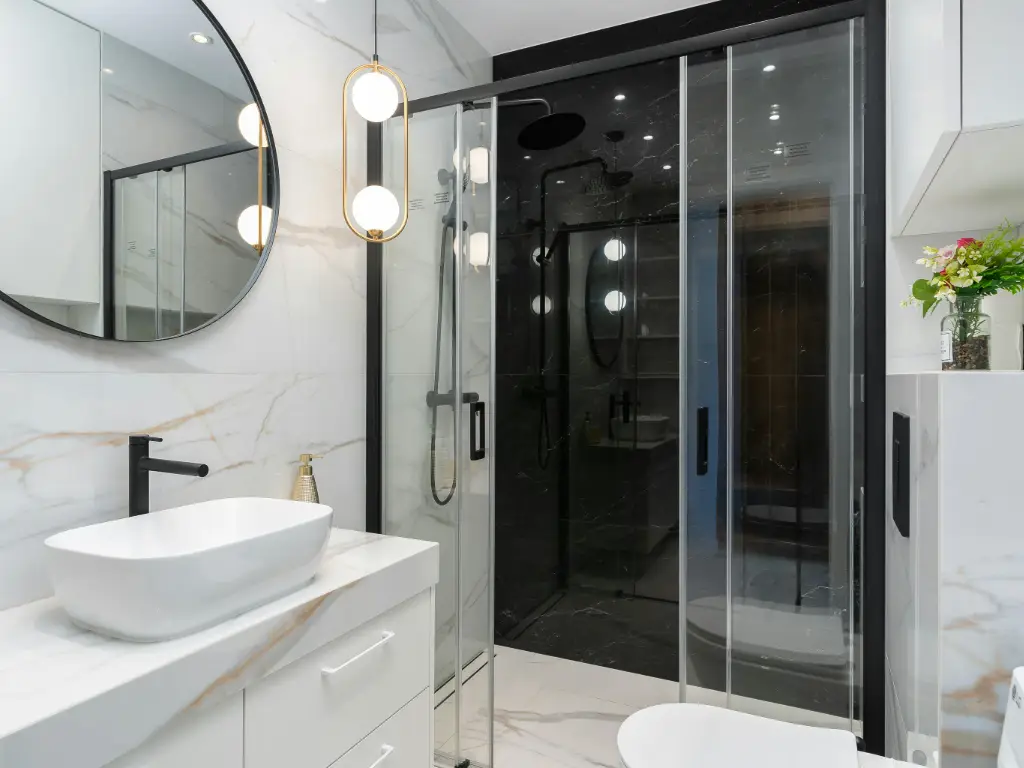Sostituire una vasca è un importante aggiornamento del bagno che può migliorare il comfort, Aumenta il valore della tua casa, e migliorare la vita quotidiana. Ma quanto costa davvero sostituire una vasca 2025?
In questa guida completa, Rompi tutto ciò che devi sapere, dai costi medi e dai prezzi per tipo di vasca e materiale, a spese nascoste e suggerimenti intelligenti per risparmiare denaro. Che tu sia un proprietario di abitazione che pianifica una ristrutturazione o un appaltatore che consiglia i clienti, Questo articolo ti darà chiari approfondimenti su cosa aspettarti.
Qual è il costo medio per sostituire una vasca in 2025?

Il costo medio per sostituire una vasca in 2025 intervalli tra $1,400 E $6,500, A seconda di diversi fattori chiave come il tipo di vasca, materiale, lavoro, e complessità idraulica.
Ecco una rottura generale:
| Tipo di progetto | Costo stimato |
| Sostituzione della vasca di base (Stessa dimensione/tipo, Nessun cambiamento importante) | $1,400 - $2,800 |
| Rimodella di fascia media (vasca aggiornata e piccoli cambiamenti idraulici) | $2,800 - $4,800 |
| Rinnovazione completa con vasca premium/personalizzata | $4,800 - $6,500+ |
Il lavoro in genere spiega 50% o più del costo totale, Soprattutto se sono necessari cambiamenti strutturali o retiling. Le vasche di lusso con caratteristiche avanzate come jet whirlpool o materiali a superficie solida possono aumentare significativamente il budget.
Fattori chiave che influenzano i costi di sostituzione della vasca da bagno

Diversi componenti influenzano il prezzo finale della sostituzione della vasca da bagno:
Tipo di vasca da bagno: Diversi stili di vasca sono dotati di prezzi diversi. Le vasche autoportanti sono spesso più costose da installare rispetto ai modelli Alcove a causa di impianti idraulici e considerazioni sullo spazio.
Materiale della vasca: Le vasche acriliche sono convenienti e leggeri, mentre le vasche in ghisa sono pesanti e costose da installare a causa delle esigenze di rinforzo strutturale.
Lavoro e installazione: Stai sostituendo la vasca in un'impronta esistente o spostando le linee idrauliche? I costi del lavoro possono variare ampiamente a seconda della complessità e delle tariffe locali.
Layout del bagno: Le case più vecchie potrebbero richiedere il rinforzo del pavimento, impianto idraulico, o anche la ricostruzione della parete per ospitare un nuovo stile o una dimensione.
Rimozione e smaltimento: Demolishing la vecchia vasca e lo smaltimento adeguato dei materiali può aggiungere $ 200- $ 600 al conto.
Funzionalità aggiuntive: Getti, basi riscaldate, illuminazione cromoterapia, o i controlli digitali aumenteranno in modo significativo il costo totale.
Costo di sostituzione della vasca per tipo di vasca
Quando si sceglie un nuovo vasca, Lo stile selezionato influenzerà significativamente il costo di sostituzione totale. Ecco una rapida panoramica dei costi medi per i tipi di vasca popolari in 2025:
| Tipo di vasca | Costo medio (Vasca + Installazione) | Dimensioni tipiche (pollici) | Ideale per |
| Alcova | $1,400 - $2,800 | 60 X 30 | Bagni standard |
| Indipendente | $2,500 - $5,000 | 55–72 x 28–34 | Moderno / Estetica di lusso |
| Drop-in | $2,000 - $4,000 | Varia | Piattaforme o dintorni personalizzati |
| Walk-in | $3,500 - $7,000+ | 52–60 x 28–32 | Anziani / Accesso alla mobilità |
| Angolo | $2,200 - $4,500 | 60 X 60 (tipico) | Grandi bagni o configurazioni spa |
| Jet Whirlpool/Air | $3,000 - $6,500+ | 60–72 x 32–36 | Installazioni di lusso simili a spa |
Vasca da bagno alcova
Una vasca da bagno alcova è l'opzione più comune e conveniente, installato tra tre pareti e tipicamente abbinato a una doccia. Le dimensioni standard sono 60 X 30 pollici, e progetta la priorità all'efficienza dello spazio. Ideale per bagni di piccole e medie dimensioni, Le vasche alcove sono facili da sostituire ed economiche da installare. La maggior parte dei modelli è disponibile in acrilico o porcellana in acciaio, E puoi aggiornare con circonnioni di piastrelle o scaffalature incorporate.
Vasca indipendente
Le vasche autoportanti sono visivamente sorprendenti e ideali per i layout del bagno aperto. Che va da 55 A 72 pollici di lunghezza, Queste vasche sono disponibili in forme scultoree come ovali, pantofola, e Clawfoot. I materiali variano da acrilico a ghisa o pietra di superficie solida. Mentre è bello, Spesso richiedono il rinforzo del pavimento e le regolazioni idrauliche, rendere l'installazione più complessa e costosa.
Vasca drop-in
Le vasche a gocce sono installate all'interno di una piattaforma o di un ponte personalizzato, Offrendo un continuo, look integrato. Comune nei bagni più grandi, Queste vasche possono variare per dimensioni e forma, A seconda della progettazione della piattaforma. Sono spesso usati nelle ristrutturazioni di alto livello in cui i proprietari di case desiderano il pieno controllo sulla piastrella circostante, mobili, o sporgenze. I costi di installazione sono più elevati a causa dell'inquadratura e della finitura richiesti.
Vasca da bagno walk-in
Progettato per la sicurezza e l'accessibilità, Le vasche walk-in presentano una porta laterale, sedile incorporato, afferrare le barre, e superfici anti-slip. Le dimensioni tipiche sono lunghe 52-60 pollici e larghe 28–32 pollici, con profondità più profonda. Ideale per gli anziani o le persone con problemi di mobilità, Queste vasche richiedono spesso installazione specializzata e possono includere idroterapia o getti d'aria. Alcuni modelli richiedono anche collegamenti elettrici per i sistemi di riscaldamento e drenaggio.
Vasca angolare
Le vasche da bagno d'angolo sono triangolari o a forma di fan, Progettato per inserirsi in un angolo del bagno. Le dimensioni medie sono 60 X 60 pollici, rendendoli più grandi e più lussuosi delle vasche standard. Sono spesso usati nei bagni principali o nei layout simili a spa. Mentre le vasche angolari offrono un fascino estetico e un comfort immerso, Le loro dimensioni e configurazione idraulica portano a costi di installazione più elevati.
Vasca idromassaggio e getto d'aria
Queste vasche di fascia alta sono dotate di acqua o getti d'aria incorporati che offrono effetti di massaggio terapeutici. Disponibile negli stili di alcova e indipendente, Le loro dimensioni vanno da 60 A 72 pollici di lunghezza. Le vasche idromassaggio usano potenti getti d'acqua, mentre le vasche d'aria forniscono gorgogliazioni delicate. Queste vasche richiedono collegamenti elettrici, Sottoclamori rinforzati, e impianto idraulico avanzato, che aumenta i costi di vasca e installazione.
Costo di sostituzione della vasca per materiale da bagno
Il materiale che scegli per la tua vasca influisce significativamente non solo sul costo iniziale, ma anche la complessità dell'installazione, durabilità, manutenzione, e ritenzione di calore. Ecco un rapido confronto dei materiali più comuni della vasca e dei costi di sostituzione medi in 2025:
| Materiale | Costo medio (Vasca + Installazione) | Durabilità | Ritenzione del calore | Peso |
| Acrilico | $1,400 - $2,800 | Moderare | Bene | Leggero |
| Fibra di vetro | $1,200 - $2,400 | Basso | Moderare | Molto leggero |
| Acciaio con enigma in porcellana | $1,500 - $2,800 | Bene | Giusto | Medio |
| Ghisa | $3,000 - $5,500 | Eccellente | Eccellente | Molto pesante |
| Superficie solida / Resina di pietra | $3,500 - $6,000 | Eccellente | Molto bene | Pesante |
| Rame | $4,500 - $7,500+ | Eccellente | Eccellente | Medio -pesante |
Vasca acrilica
Le vasche acriliche sono leggere, conveniente, e disponibile in varie forme e colori. Mantengono bene il calore e resistono alla muffa, ma può graffiare facilmente nel tempo. La loro facilità di installazione li rende una scelta migliore per i rimodelli residenziali.
Vasca da bagno in fibra di vetro
La fibra di vetro è il materiale più economico, rendendolo ideale per lavori di ristrutturazione o noleggio rapidi. Mentre è facile da installare e riparare, È incline a graffiare, sbiadimento, e cracking con un uso frequente nel tempo.
Vasca in acciaio con aria in porcellana
Queste vasche offrono un liscio, finitura lucida a un prezzo di fascia media. Sono resistenti alla maggior parte delle macchie e dei graffi, ma può chip se colpito. Sono più pesanti della fibra di vetro ma più facili da installare rispetto alla ghisa.
Vasca da bagno in ghisa
Le vasche da ghisa sono estremamente resistenti e lussuose, con ritenzione di calore senza pari. Il loro look classico e la durata lunga giustificano il costo più elevato, ma a causa del loro peso, L'installazione richiede spesso il rinforzo del pavimento.
Superficie solida / Vasca da bagno in resina in pietra
Realizzato in pietra ingegnerizzata o resina composita, Queste vasche forniscono una fascia alta, Look moderno con un eccellente isolamento. Sono pesanti e più costosi ma offrono senza soluzione di continuità, finiture opache e una durata eccezionale.
Vasca da bagno in rame
Le vasche di rame sono premium, Prodotti artigianali che offrono proprietà antimicrobiche naturali e un'estetica sorprendente. Mantengono bene il calore e durano per decenni, Ma arriva a un prezzo elevato e richiedi una lucidatura occasionale per mantenere la loro patina.
Spese aggiuntive a NoTioCe Per durante una ristrutturazione della vasca

Oltre la vasca e l'installazione, Ci sono diversi costi che trascurerai:
- Demolizione e smaltimento: $200- $ 600
- Modifiche idrauliche: $400- $ 1.500
- Lavoro delle piastrelle o surrounds: $900- $ 2,500
- Membrane impermeabilizzanti: $150- $ 400
- Nuovi infissi o raccordi (rubinetti, scarichi): $150- $ 600
- Permessi e ispezioni: Varia in base alla posizione
Come risparmiare denaro sulla sostituzione della vasca da bagno?

Cercando di tenere sotto controllo i costi? Qui ci sono strategie intelligenti per ridurre le spese:
- Attenersi alla dimensione e al layout della vasca esistenti: Scegliere una nuova vasca che corrisponda all'impronta attuale evita costosi impianti di rilevamento e modifiche strutturali.
- Scegli materiali economici: Le vasche acriliche e in fibra di vetro sono convenienti, facile da installare, e offrire ancora finiture eleganti con una buona conservazione del calore.
- Tempo la tua ristrutturazione strategicamente: Pianifica il tuo progetto durante la bassa stagione (tardo autunno o inverno) Quando gli appaltatori possono offrire tariffe più basse e i produttori promuovono sconti.
- Confronta più citazioni degli appaltatori: Ottieni sempre almeno 2-3 citazioni. Non solo confrontare il prezzo: guarda l'esperienza, garanzia, e tempi di installazione.
- Gestisci da solo compiti semplici: Se sei a tuo agio, Rimuovere la vecchia vasca o preparare il sito prima che i professionisti arrivino per risparmiare sui costi del lavoro.
- Lavora con un produttore affidabile della vasca da bagno: Collaborando con un fornitore di fiducia come Kjbath Garantisce la qualità del prodotto, Garanzia a lungo termine, e prezzi competitivi: il mancato evitare costose riparazioni o sostituzioni lungo la linea.
- Progetti del bagno del bundle: Aggiornamento della tua vasca, vanità, e il bagno insieme può ridurre le commissioni di installazione complessive attraverso un singolo contratto di lavoro.
Perché scegliere Kjbath per la tua prossima sostituzione della vasca da bagno?
Lavorare con un produttore di fiducia come Kjbath ti aiuta a risparmiare senza sacrificare la qualità. Offriamo una vasta gamma di stili e materiali per vasca a prezzi diretti della fattoria, ideali sia per gli appaltatori che per i proprietari di case. Tutte le nostre vasche sono testate sulla durabilità e supportate dalla garanzia, Con dimensioni personalizzate opzionali per soddisfare le tue esigenze specifiche. Dalla spedizione rapida al supporto reattivo, Kjbath garantisce un'esperienza di sostituzione regolare ed economica dall'inizio alla fine. Contattaci oggi!






